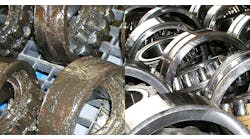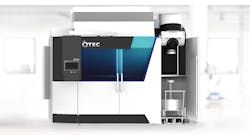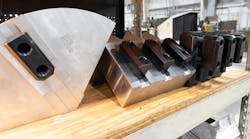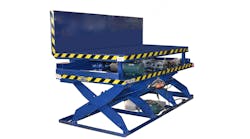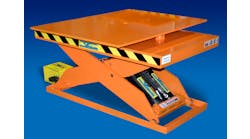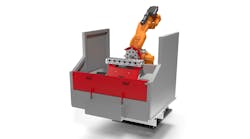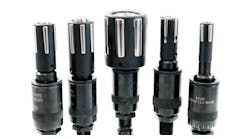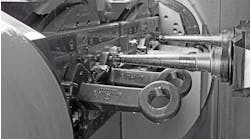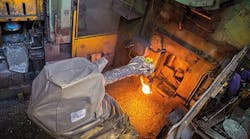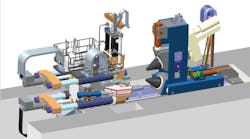Fully automated production is a manufacturing concept that many forgers and others find hard to imagine: their work is too specific and sensitive to be programmed, they contend, or the working conditions are too extreme to expect robots to perform reliably there. But, two plants operated by a producer of closed-die forgings for automotive and heavy machinery buyers, are demonstrating that “complete robotization” not only is possible — it makes critical operations more reliable and improves plant productivity.
San Grato SpA’s two plants are capable of forming more than 10 million parts per year, in sizes up to 800 mm long, diameters up to 350 mm, and weighing 0.5 up to 30 kg. The series of Comau SpA robots in place to tend the sequenced hot-forming presses guarantee the reliability needed to maintain effective cycle times for this type of processing, in addition to providing relief from the most demanding tasks for operators in this environment, where the high temperatures, noise, and repetitive heavy lifting make work very taxing.
In addition, San Grato’s automation experience shows that robotics need not lead to staff cuts. Rather, the robots have helped workers to expand their skills to cover the demands of programming and managing the automated lines.
Most important, the increases in productivity and quality achieved thanks to the automation systems have enhanced the competitive standing of San Grato, which has found increased demand for its products and thereby prompted the group to expand its activities.
Step-by-step automation
“The production process at San Grato starts at the induction furnace, which heats 12-meter bars of varying thickness,” according to Antonio Bevacqua, manager of San Grato’s two plants, at San Carlo Canavese and at Malonno. “The bars are cut while they’re hot and the production steps with robotics begins immediately afterwards.
“The first robot picks the piece and takes it to the press for the initial ‘crushing’, which actually scorifies the piece,” he continued. “A second robot then takes the piece and deposits it in the preforming mold, before it is picked by another robot, which inserts it in the mold that will produce the finished part.
“At that point, other robots manipulate the piece to carry out other machining operations, that is, automatic deburring and reflanging. Finally, the piece is positioned on the cooling tunnel to dramatically decrease its temperature,” the manager concluded.
The entire line is completely automated by the functions of the Comau robotics. “We’ve taken important steps forward,” Bevacqua emphasized, “because the line starts from the heat slitting machine at the exit of the furnace, goes on to govern the four in-line presses, in turn controlled by five Comau robots.
“We’ve automated the production of steel pieces from 1 kg up to 30 kg,” he noted, “and that’s not all. Nearly all of the formed parts, once they reach the end of the production process, are taken to the 100% quality control line: here, there are two units, also completely automated using Comau robotics, that manage all the phases from cold coining up to the magnetic flux tester, in which the piece is held in position for a final visual inspection by the operator.
“The choice of using only Comau robots, with which we are greatly satisfied, delivers to us economies of scale in terms of spare parts, too. This choice has led us, over time, to replace all previous robotics with Comaus,” the manager indicated.
Listing the advantages
This mass robotization project has delivered several advantages. First, a series of very heavy-duty tasks in hostile environments are no longer performed by people, but rather by the machine. The result is that process errors are avoided, and production volume and efficiency are promoted. These are important results, of course, but as Antonio Bevacqua noted, “the point we’ve reached is not a point of arrival at all. If anything, it’s a starting point.”
The starting point, that is, for finding more effective ways to perform the various forging sequences. Giovanni Baronio, whose systems integration business E6Pos worked with the San Grato operators to define and program the automated line, maintained that “all the robots used — that is, the Comau Smart NJ 165, Smart NJ 130, Smart NJ 60, and Smart NS 12/16, all outfitted with protective dressing that insulates the machinery from high heat — proved more than capable of satisfying our expectations in the phases of machine control, press-to-press motions, and handling activities in which we applied them.”
For example, Baronio explained how the robots were customized with special end-of-arm gripping tools. “We put a lot of work into the gripping of parts, because the type of piece to be handled requires very precise technical study, leading us to build clamps that are nearly uniform for the entire process, and to greatly reduce the changes in equipment, which occur only when the batch changes.”
Thus, for San Grato’s robotized operations, tool changing was pared down to a minimum number of variations. The gripper design also helped to accomplish speed in the changing process. “It’s quick,” concluded the automation integrator, “because the whole clamp is not changed, just the gripper jaws. The wrist attachment is standard on nearly all the Comau robots used. So, we can change just the grip when we change the part being produced.”
Commitment and confidence
Achieving these results was possible thanks to the shared goals of all those involved, according to both Baronio and Bevacqua. The ownership of San Grato, its managers, workers and technicians, as well as its suppliers, deserve the recognition, they agreed.
Bevacqua gave first recognition to the Fresia family, owners of the manufacturing group, whom he described as the driving force at San Grato. The atmosphere that encourages innovation is critical for remaining competitive in the manufacturer sector, he said.
“We’re compelled to automate,” he observed, “and the journey that we’ve begun wouldn’t have been possible without the will and confidence to change and innovate constantly from the owners of this company.”
The spirit of innovation starts with good leadership, but only by having the entire organization acting in that spirit can innovation be realized, he observed.
“Our challenge continues,” according to Bevacqua, “because the whole team is pushing for the same result. San Grato, like every other company, especially at this time, cannot allow staff numbers to exceed what is necessary.
“But, automation has allowed us to train our operators better, without reducing their numbers. They were the first to overcome any mistrust and believe in it, lending form to the process of innovation and change,” he insisted.
“Robotizing this company indicated a path for all the workers to follow,” the manager recalled, “in particular maintenance staff. These people need good technique and experience as part of their background, together with the training that has become essential for optimal use of the automation now present on all production lines.”
The results may be seen in San Grato’s current employment figures: it has nearly 200 workers at the two plants, and the company is pursuing ISO 18.000 OHSAS occupational safety certification, demonstrating its total commitment in the automation strategy.
San Grato has asked every supplier to make a similar commitment. “With E6Pos, we fight a battle against cycle time every day,” Bevacqua revealed. “Since Comau made us aware of this system integrator, a relationship of direct partnership has existed that over time has given rise to a relationship of complete trust.”
That sentiment was confirmed by Giovanni Baronio: “For E6Pos, having a liaison like the one we’ve found in the manager (Antonio Bevacqua) is of fundamental importance, because the level of competence is decidedly high. We have an immediate understanding, without switching between endless designs on paper and subsequent technical assessments in between.
“This is also because we don’t have the time,” Baronio joked. “The cycle time would be affected and it isn’t in Bevacqua’s work plan …”


